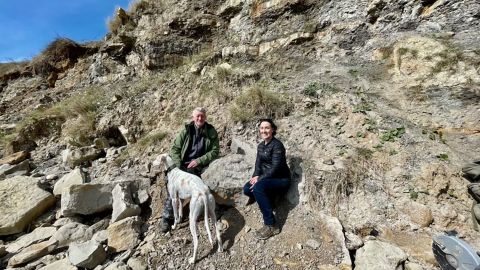Sign up for CNN’s Wonder Theory science newsletter. Explore the universe with news on fascinating discoveries, scientific advancements and more.
CNN
—
A giant carnivorous dinosaur likely rested or crouched down in Yorkshire 166 million years ago, deeply pressing its feet into the ground. The colossal creature left behind a record-breaking footprint recently discovered along the United Kingdom’s “Dinosaur Coast.”
The Jurassic footprint, measuring nearly a meter (3.3 feet) long, is the largest of its kind found in the county of Yorkshire.
Thousands of dinosaur footprints and many fossils have been recovered over the years along the Yorkshire coast. But this discovery was made in April 2021 by local archaeologist Marie Woods as she walked along the coast.
“I couldn’t believe what I was looking at, I had to do a double take,” Woods said in a statement. “I have seen a few smaller prints when out with friends, but nothing like this. I can no longer say that ‘archaeologists don’t do dinosaurs.’”
Woods is the coauthor of a study describing the footprint that was published Tuesday in the journal Proceedings of the Yorkshire Geological Society.
Woods reached out to paleontologist Dr. Dean Lomax, honorary visiting scientist at the University of Manchester, to get his thoughts on what she found at Burniston Bay, about 3 miles (5 kilometers) north of Scarborough. Just the day before, Lomax had shared an image of a dinosaur footprint found in the same area in 2006.
“Marie contacted me whilst she was down on the beach, with the fossil in front of her,” said study coauthor Lomax, who is also the author of “Dinosaurs of the British Isles.”
“At first, to be totally honest, I thought that it was some sort of joke,” he said via email. “The fact Marie then went out and saw this down on the beach seemed impossible. Plus, Marie is an archaeologist, and she and I have always joked that she’ll one day make an amazing palaeontological discovery.”
The three-toed footprint is one of only six to be found in the area, and the first one was found in 1934.
“This important discovery adds further evidence that meat-eating giants once roamed this area during the Jurassic,” said lead study author and local geologist John Hudson. “The type of footprint, combined with its age, suggests that it was made by a ferocious Megalosaurus-like dinosaur, with a possible hip height between 2.5 and 3 meters (between 8.2 and 9.8 feet).”
Megalosaurus was the world’s first official dinosaur, named in 1824 for bones discovered in the county of Oxfordshire in England, Lomax said.

The carnivorous dinosaur, one of the largest predators of its time, had a large skull armed with sharp, serrated teeth, and its body reached 8 to 9 meters (26.2 to 29.5 feet) in length.
Concerned that the footprint might erode more if left along the coast, the team arranged for it to be safely moved. Fossil collectors Mark, Aaron and Shae Smith carefully collected the footprint and donated it to the Scarborough Museum and Galleries.
“We’re incredibly grateful to Mark, Aaron and Shae for rescuing this important specimen and ensuring that it was saved for science,” Lomax said. “Now that the specimen has been studied, plans are in motion for it to go on public display, to spark the imagination of the next generation of fossil hunters.”
Hudson and Lomax were able to study the footprint in detail once it was relocated, which enabled the researchers to learn more about the dinosaur who left the impression behind. The duo analyzed the shape of the footprint, number of toes and claw marks, as well as impressions made by the dinosaur’s skin.
“The most intriguing feature of our footprint is a long portion preserved at the back of the foot, which is an impression of what we call the metapodium,” Lomax said.
“The presence of this might suggest our large meat-eater was squatting down in the mud, before standing up and walking away. It’s fun to think this dinosaur might well have been strolling along a muddy coastal plain one lazy Sunday afternoon in the Jurassic.”

Hudson and Lomax also worked with geologist Dr. Mike Romano, an emeritus member of the faculty at the University of Sheffield, on the study. Romano has collected and studied hundreds of dinosaur tracks along the Yorkshire Coast over the past two decades. About 25 different types of dinosaur footprints have been identified in the area.
“The east coast of Yorkshire is known as the Dinosaur Coast for very good reasons,” Romano said in a statement.
“Although these different types do not necessarily represent the same number of different dinosaurs, they do indicate a diverse ecosystem of animals including both carnivores and herbivores that roamed the Jurassic coastal plain and (river) complex some 160-175 million years ago. The prints also allow us to interpret their behaviour. Thus, we have records of walking, running and swimming dinosaurs.”
Once work has been completed on the fossilized footprint, it will go on public display among others at the Scarborough Museum and Galleries’ Rotunda Museum.